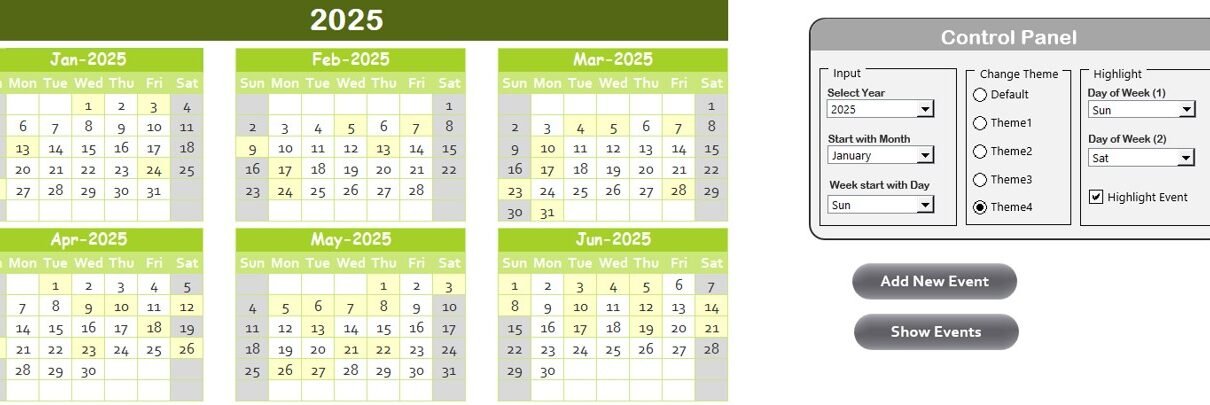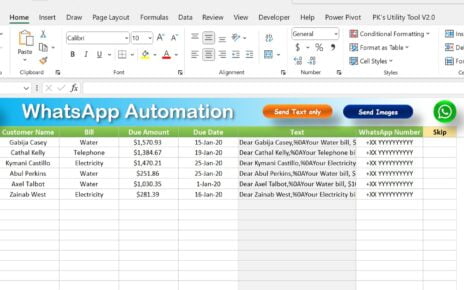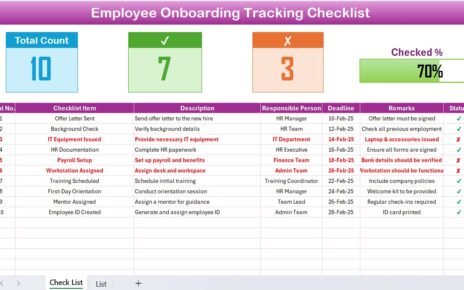In the world of business, maintaining a clear and organized expense tracking system is crucial for both short-term budgeting and long-term financial planning. One of the most effective ways to manage business expenses is by using a Business Expense Calendar in Excel. This tool provides you with an intuitive and easy-to-navigate method to monitor and track your business expenses, from daily purchases to yearly projections.
A well-structured Business Expense Calendar in Excel not only helps you keep track of your spending but also allows you to plan for upcoming costs and events, ensuring that you never miss important deadlines or financial obligations.
In this article, we’ll walk you through the features of the Business Expense Calendar in Excel, how it can help streamline your financial management, and the best practices for utilizing it to its full potential.
Table of Contents
ToggleWhat is a Business Expense Calendar in Excel?
A Business Expense Calendar in Excel is a template that allows businesses to organize and track their financial transactions over a specified time period. The calendar includes various views—annual, monthly, and daily—that help break down complex financial data into easily digestible chunks.
This tool allows you to:
- Record business expenses on a daily, monthly, or yearly basis.
- Set reminders for recurring expenses like rent or utility bills.
- Track the status of each expense, whether it is paid, pending, or overdue.
- Analyze your spending patterns and identify areas where you could save money.
Key Features of the Business Expense Calendar in Excel
The Business Expense Calendar in Excel is packed with powerful features that can enhance your financial tracking and management. Let’s take a look at the key features of this tool:
1. Home Sheet: The Central Hub
The Home Sheet serves as the starting point for your Business Expense Calendar. It includes navigation buttons that make it easy to jump to different sections of the workbook. Here’s what you’ll find:
- Annual View Button: Access the full year’s calendar to get a big-picture view of your expenses.
- Monthly View Button: View a more focused calendar for any selected month.
- Daily View Button: Check your expenses for any given day or date range.
- Events: Manage any special events, such as financial milestones or upcoming payments.

Click to Business Expense
2. Annual View Sheet: A Year at a Glance
The Annual View Sheet gives you a broad overview of the entire year, displaying all months in one place. This sheet includes several useful features:

Control Panel:
- Input Group: Select the year and month to change the calendar automatically.
- Change Theme Group: Choose from five color themes to customize the look of your workbook.
- Highlight Group: Highlight specific days of the week, such as weekends or important event dates (e.g., due dates for bills).

Click to Business Expense
Event Management:
- Add New Event: You can add new financial events, such as invoices or bill payments, by selecting a date and filling out an easy form.

Click to Business Expense
- Show Event: View all events scheduled for a specific date.
3. Monthly View Sheet: Focus on the Current Month
The Monthly View Sheet provides a more detailed look at a selected month’s expenses. You can easily adjust the year and month and track all expenses for that period. It also allows you to:
- Add New Event: Just like the Annual View, you can add new events for any specific day of the month.
- Show Event: See a list of events scheduled for any selected date.

Click to Business Expense
4. Daily View Sheet: Expense Tracking by Date Range
The Daily View Sheet is where you can track expenses over a specific date range. This is perfect for monitoring daily expenses or for analyzing spending over a specific period. Key features include:
- Date Range Selection: Use the calendar icon to select the start and end dates.
- Add New Event: Add any new expense or financial event that occurs within your chosen range.
- Refresh Button: To ensure you’re seeing the most up-to-date information, you can refresh the data for the selected range.

Click to Business Expense
5. Events Sheet: The Expense Database
The Events Sheet stores all your expense and event data in a structured format. Each event is tracked with the following key data points:
- ID: Auto-generated unique identifier for each expense or event.
- Date: The date when the expense occurred or is due.
- Day: The day of the week (e.g., Monday, Tuesday).
- Event Name: Name of the expense or event (e.g., “Office Supplies”, “Electric Bill”).
- Time: Time of the expense.
- Location: If applicable, the location where the expense occurred.
- Description: A brief note about the expense or event.

Click to Business Expense
Buttons for managing your data:
- Add New Record: Adds a new expense event.
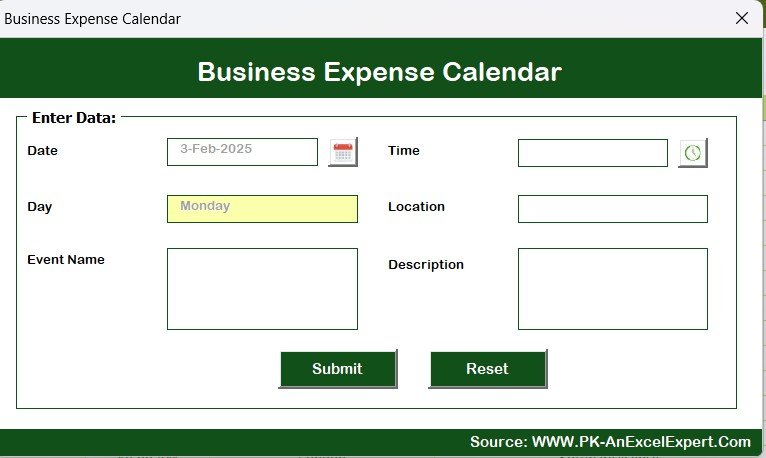
Click to Business Expense
- Update Existing Record: Update an existing event record by selecting the event ID.
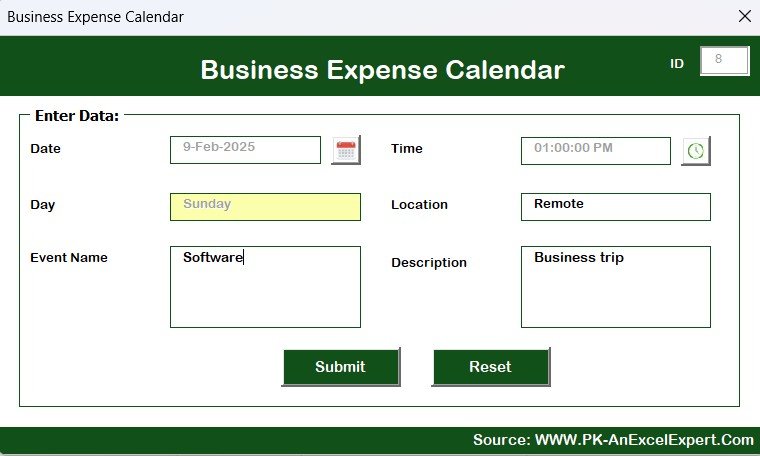
Click to Business Expense
- Delete Record: Delete a record that is no longer relevant.
Advantages of Using a Business Expense Calendar in Excel
There are many benefits to using the Business Expense Calendar in Excel, including:
- Easy Tracking of Expenses: You can track all your business expenses in one centralized location, whether it’s rent, supplies, or utility bills. This makes it easier to see where your money is going and identify potential savings.
- Customization for Your Specific Needs: The calendar is highly customizable. You can change the starting month, adjust the color themes, and highlight key dates such as bill due dates or financial milestones.
- Streamlined Financial Management: With multiple views (Annual, Monthly, and Daily), you can manage your expenses effectively, ensuring that you never miss an important payment or event.
- Increased Accuracy: By tracking your expenses in real-time, you can avoid errors that often occur with paper-based tracking systems or other manual methods.
Opportunities for Improvement in the Business Expense Calendar
While the Business Expense Calendar in Excel is a robust tool, there are several opportunities for improvement:
- Integration with Other Tools: Integrating the calendar with other accounting tools or software like QuickBooks or Xero could help streamline financial tracking and reporting.
- Mobile Accessibility: Creating a mobile-friendly version of the calendar would allow users to access and update their expenses on the go.
- Automatic Expense Categorization: Including features that automatically categorize expenses (e.g., utilities, office supplies) could further improve ease of use.
- Integration with Bank Accounts: Integrating the calendar with bank accounts for real-time tracking and automatic expense updates would be a game-changer for businesses.
Best Practices for Using the Business Expense Calendar in Excel
To get the most out of your Business Expense Calendar in Excel, consider these best practices:
- Regular Updates: Regularly update your calendar with new expenses, payments, and events to ensure it reflects your current financial situation.
- Backup Your Data: Since the calendar contains important financial information, make sure to regularly back it up to prevent any data loss.
- Use Color Coding: Using different colors to distinguish between categories of expenses (e.g., bills, supplies, travel) will make the calendar easier to read and navigate.
- Set Reminders for Recurring Expenses: Set up reminders for recurring expenses like monthly bills or yearly subscriptions. This ensures that you never miss a payment.
- Analyze Your Expenses: Periodically analyze your expenses to identify trends. Look for patterns in your spending that could highlight potential areas for cost savings.
Conclusion
The Business Expense Calendar in Excel is a powerful tool that can help businesses streamline their financial management. Whether you’re tracking daily, monthly, or yearly expenses, this Excel template provides all the necessary features to ensure that your finances are organized, accurate, and up to date.
By following the best practices and making use of the various views, you can make the most of this tool to improve your business’s financial planning and decision-making. Additionally, the calendar’s customization options allow it to be tailored to your specific needs, making it a flexible and efficient solution for any business.
Frequently Asked Questions (FAQs)
How can I add a new expense to the Business Expense Calendar in Excel?
To add a new expense, simply select the date on the calendar, click on the “Add New Event” button, and fill in the necessary information about the expense.
Can I track expenses for multiple years with this calendar?
Yes, the Business Expense Calendar allows you to select any year and change the calendar accordingly.
How do I categorize my expenses in the calendar?
While the calendar doesn’t categorize expenses automatically, you can add categories in the description or use color coding to distinguish between different types of expenses.
Can I customize the calendar themes?
Yes, the Business Expense Calendar offers five color themes that you can choose from to apply to the entire workbook.
Can I delete an expense entry?
Yes, you can delete an expense by selecting its ID in the Events Sheet and clicking the “Delete Record” button.
Visit our YouTube channel to learn step-by-step video tutorials
